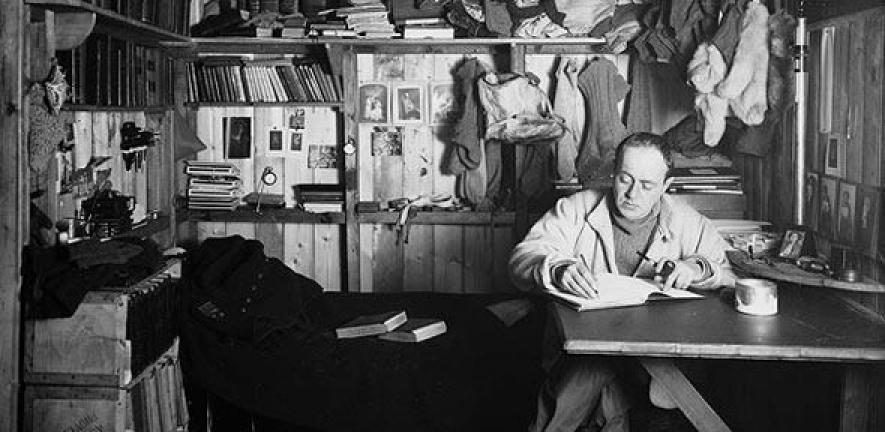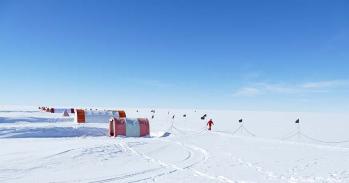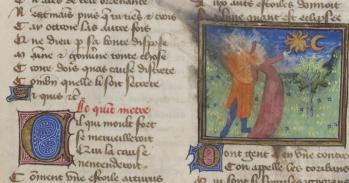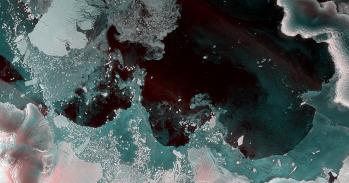
A letter written by the dying Captain Scott - one of only two remaining in private hands - can be revealed in full for the first time after being acquired by the Scott Polar Research Institute at the University of Cambridge.
A letter written by the dying Captain Scott - one of only two remaining in private hands - can be revealed in full for the first time after being acquired by the Scott Polar Research Institute at the University of Cambridge.
I want to tell you that I was not too old for this job. It was the younger men that went under first.
Captain Scott
Written by Scott from his final Antarctic camp at the very end of his life in March 1912, the letter to Admiral Sir Francis Bridgeman speaks poignantly of Scott’s anxiety for his family and his hope that he and companions have set a good example. The acquisition of this letter is of considerable importance for the United Kingdom’s polar heritage.
It is being revealed to the public 101 years to the day since Captain Scott’s final diary entry (March 29, 1912).
Though previously quoted in part, its full contents have remained unknown to the wider public until today, having passed into private hands following delivery to Bridgeman
It will now take its place at SPRI alongside the other ‘last letters’ written to his widow Kathleen Scott, Mrs Oriana Wilson, Mrs Emily Bowers, Sir Reginald Smith and George Egerton. The only other last letter in private hands, written to Edgar Speyer, was sold last year at auction for £165,000.
Scott is known to have written to his friend, the author JM Barrie, but the whereabouts of this letter are completely unknown.
SPRI Archivist, Naomi Boneham said: “It seems very fitting that we should be able to announce this major acquisition exactly one hundred and one years after Scott’s final diary entry. We intend to put the letter on public display in the Polar Museum as soon as it has been conserved.”
Admiral Sir Francis Charles Bridgeman Bridgeman GCB, GCVO (7 December 1848 – 17 February 1929) was a Royal Navy officer. As a Captain he commanded a battleship and then an armoured cruiser and then, after serving as second-in-command of three different fleets, he twice undertook tours as Commander-in-Chief of the Home Fleet with a stint as Second Sea Lord in between those tours. He became First Sea Lord in November 1911. He had been Scott's Commanding Officer.
Thanks to donations from the V&A Purchase Grant Fund, the John R Murray Trust, the Friends of the National Libraries and Dr Richard Dehmel, the University of Cambridge has been able to make the purchase for the sum of £78,816. The letter was sold by Lord and Lady Graham, descendants of Sir Francis Bridgeman.
The Institute was delighted to be offered the opportunity to acquire Scott’s letter to Bridgeman, along with associated correspondence, as the majority of the surviving letters are already held in the collections of the Scott Polar Research Institute and are publicly accessible via its Polar Museum. They are among the museum’s greatest treasures.
SPRI’s Librarian & Keeper of Collections, Heather Lane, said: “Without the generous support of these organisations and individuals we would not have been able to secure this important manuscript. It is extraordinary to think that the letter will now be reunited with the others written by Scott in the Antarctic over 100 years ago.”
The final letters written in March 1912 from the Antarctic to family and friends by Captain Scott and his companions, Dr Edward Wilson, Captain Lawrence Oates and Lt. Henry Robertson Bowers, are of major significance to the national heritage. No letters are known to survive from P.O. Edgar Evans, the fifth member of the Polar Party. In the case of Scott, this letter clearly expresses his feelings as he lay dying and is a testament to the qualities of endurance which propelled Scott to the status of a national hero.
We know much about the expedition from Scott’s personal journal, which was bequeathed to the nation and is held by the British Library, which kindly lent the final volume for a temporary exhibition at the Polar Museum in 2012 to mark the centenary of Scott’s achievement of the South Pole. As the extract below illustrates, the Bridgeman letter is an important addition to the story as it conveys Scott’s feelings at the very end of his life. It has never been reproduced in full in any of the editions of Scott’s writings.
Its purchase enables this letter to be reunited with the others written from the tent on the Great Ice Barrier, already in the Institute’s care, and with the photographs, sledging journals and personal diaries of Scott and his team, which form the most comprehensive record of the expedition held anywhere.
SPRI is the oldest international centre for polar research and is world-renowned for research and reference in a variety of fields relating to the environment, history, science and social science of the polar regions. The Institute was founded in Cambridge, as a memorial Scott and his four companions, who died returning from the South Pole in 1912. As well as research programmes, the Institute provides access to its library, archives and museum for the general public and has a strong educational outreach programme on the Arctic and Antarctic, ice and environmental change. It houses the largest public collection of historic archives, photographs and artefacts from polar expeditions in the United Kingdom.
Text of the letter:
To Sir Francis Bridgeman
My Dear Sir Francis
I fear we have shipped up – a close shave. I am writing a few letters which I hope will be delivered some day. I want to thank you for the friendship you gave me of late years, and to tell you how extraordinarily pleasant I found it to serve under you. I want to tell you that I was not too old for this job. It was the younger men that went under first. Finally I want you to secure a competence for my widow and boy. I leave them very ill provided for, but feel that the country ought not to neglect them. After all we are setting a good example to our countrymen, if not by getting into a tight place, by facing it like men when we were there. We could have come through had we neglected the sick.
Good-bye and good-bye to dear Lady Bridgeman
Yours ever
R. Scott
Excuse writing – it is -40, and has been for nigh a month
This work is licensed under a Creative Commons Licence. If you use this content on your site please link back to this page.





